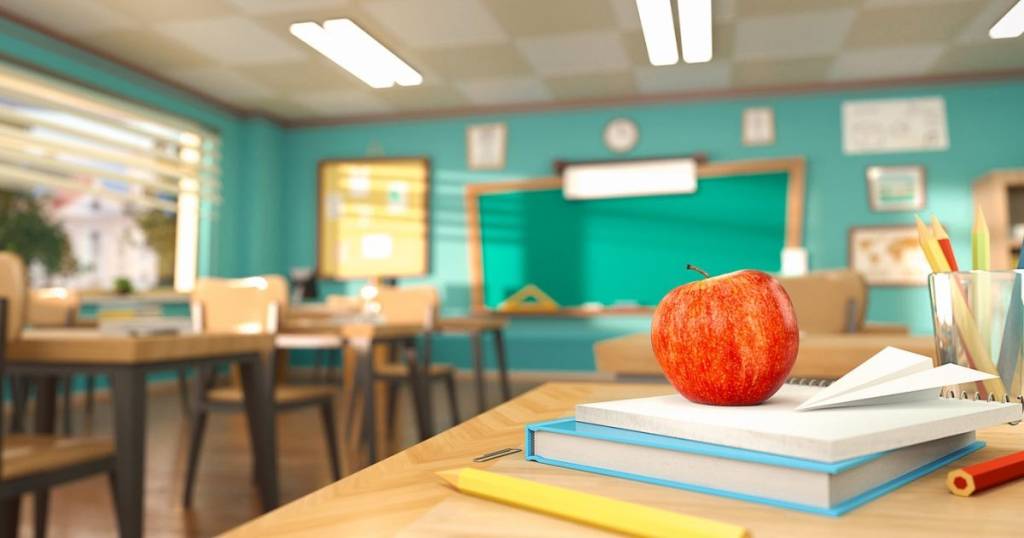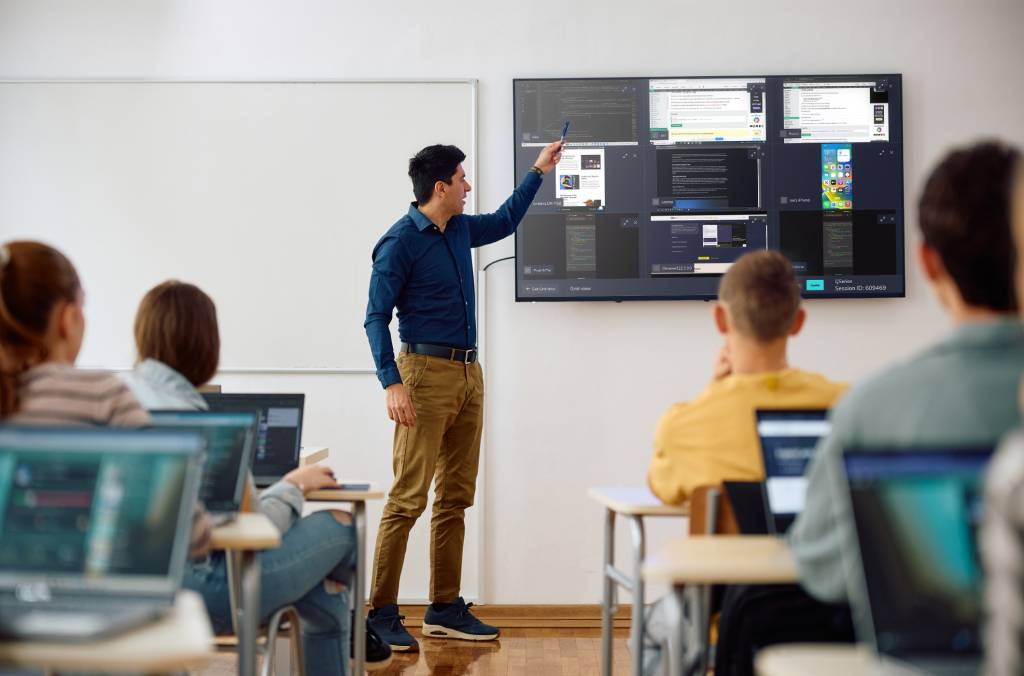
Is ‘traditional teaching’ obsolete in the new era of blended learning?
 Julie Adams
•
Sep 15, 2021
Julie Adams
•
Sep 15, 2021
This article is written by Julie Adams, Senior Communication and Content Specialist at DisplayNote.

Educators will be only too familiar with the notion of ‘sage on the stage’ vs ‘guide on the side’ when it comes to the great teaching debate. Opponents of both sides will defend their approach and its place in the classroom; disparaging the other side. However, this binary view doesn’t encapsulate modern teaching. Good teachers will sit somewhere in the middle of the continuum, employing a combination of one or both approaches at the same time, as and when applicable.
Sage on the stage
Dating back to the 1500s, ‘sage on the stage’ (or chalk and talk as some call it), refers to teaching where an educator imparts knowledge by lecturing to their class. Students are expected to take notes, memorize, and regurgitate this information on request – with little feedback. It is quite a passive, unidirectional process whereby the teacher transmits their knowledge and the students absorb it. This method of teaching is often considered a “teacher-centered model” or “traditional” approach.
Guide on the side
On the other hand, ‘guide on the side’ takes a more modern, student-centered approach to teaching. In this context, the teacher is viewed more as a facilitator of active learning – to guide the students to their own personal discoveries and internalized understanding of the content.
This approach, which became more popular in the 1990s as schools started to focus more on personal development and critical thought, places more emphasis on active learning. The teaching will take a ‘student-centered approach, spending more one-on-one time working with smaller groups, initiating discussions, and setting activities that help to consolidate and connect the teaching materials for each student.
From ‘chalk-and-talk’ to constructivism

In an era where child poverty has significantly decreased compared to the decades before and more children than ever are completing basic education, the traditional, utilitarian style of teaching has become less of a necessity. Schools are no longer tasked solely with the task of cultivating their students’ cognitive capacities (literacy, numeracy, problem-solving). In most counties, there is now the basic standard of living and available resources that education has evolved beyond simply learning to read and write. Schools now also aim to develop the social, ethical, and emotional capacities and dispositions of their students.
And it isn’t just western education systems that are looking in new directions which it comes to the curriculum. India announced a new education policy in 2020 that includes objectives such as; creativity and critical thinking, ethics, human rights & constitutional values, promoting multilingualism and the power of language; general life skills; extensive use of technology; respect for diversity, and local context.
It could be argued that sage on a stage alone does not have the capacity to address these learning objectives.
Guide on the side encapsulates much of the sentiments of constructivism. As a theory of learning, constructivism suggests that students have to actively construct understanding from the information provided by the teacher, and other sources. According to this view, it’s not possible for the student to obtain the same knowledge the teacher has by the teacher simply by telling them about it. This is likely to produce what A. N. Whitehead referred to as ‘inert’ knowledge, i.e., knowledge which is simply stored rather than being applied or tested.
How has online learning impacted teaching?
Fast-forward to 2021, in the wake of a global pandemic that uprooted the foundations of the education sector and teaching, moved online. Faced with the challenge of delivering lessons to students online, ‘sage on the stage’ was off the menu. Covid-19 created a sense of urgency for better content, which in turn made it a necessity.
One study published in September 2020 looked at the experience of schools in Norway. The results suggested that the pandemic had actually improved the learning experience for pupils and teachers: “There was more creative learning, better progress, more useful feedback, and greater student independence.”
However, it’s important to note the disparity that exists between the homeschooling experiences of children from different socioeconomic backgrounds. Another 2020 study found that children from the poorest families were the least likely to have access to the devices needed and internet access at home.
It’s all about the content

The teachers that have flourished during the pandemic are those who took a flexible approach and adapted their lessons to the constraints of online learning. Instead of simply imparting knowledge to their students, they designed content that would keep eyeballs on the screen. They used polls, quizzes, and interactive testing to gamify the content mastery process and keep students engaged from their kitchen tables.
Having been exposed to it, it’s likely that students will continue to expect this type of rich, interactive content when the pandemic is over. This creates both a challenge and opportunity for schools, to provide teachers with the tools to deliver the same engaging content.
The future is blended
As technology forges a more permanent and central role in the classroom, it’s likely that student-centered teaching will come along with this. As digital twin models become more popular in education, online lesson resources will enable asynchronous learning in the 85% of time students aren’t at school. There will be less of a need for students to furiously take down notes from the board, they will instead have more time to engage with content independently outside of the classroom.
This in turn frees teachers up to spend less time ‘chalk and talking’ the content, and more time to interact with the students on a one-to-one basis. BYOD-enabled classrooms will further facilitate the mastery evaluation process, whereby teachers can review and feedback on individual students’ work much more efficiently.
Striking a balance between teacher and student-focused learning was something we took into consideration when designing our screen-sharing tool, Montage. Made for the classroom, Montage is the smart collaboration tool that lets you share your content on the main display. Whether it’s a presentation, document, or webpage – Montage makes it easy for teachers and students to wirelessly screen their share from any device.

The built-in smart collaboration tools support active learning in the classroom. With Grid View, you can view up to 4 streams on the main display at once to quickly compare multiple students’ work. This is great for group projects or sharing working examples – it gets the whole class involved.
Moderator Mode and Screen Annotation also keep the teacher in control when presenting to the class. Being able to present and annotate at the same time allows you to add context to the content, drawing the class’s attention to specific points for emphasis.
Discover the benefits of Montage in your classrooms – start your free 30-day trial.
Want to stay in the loop?
Keep up-to-date with everything DisplayNote – including new releases, job openings, and customer giveaways.
Don’t worry, we’ll not spam you and we’ll never share your email with anyone







